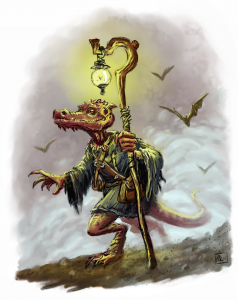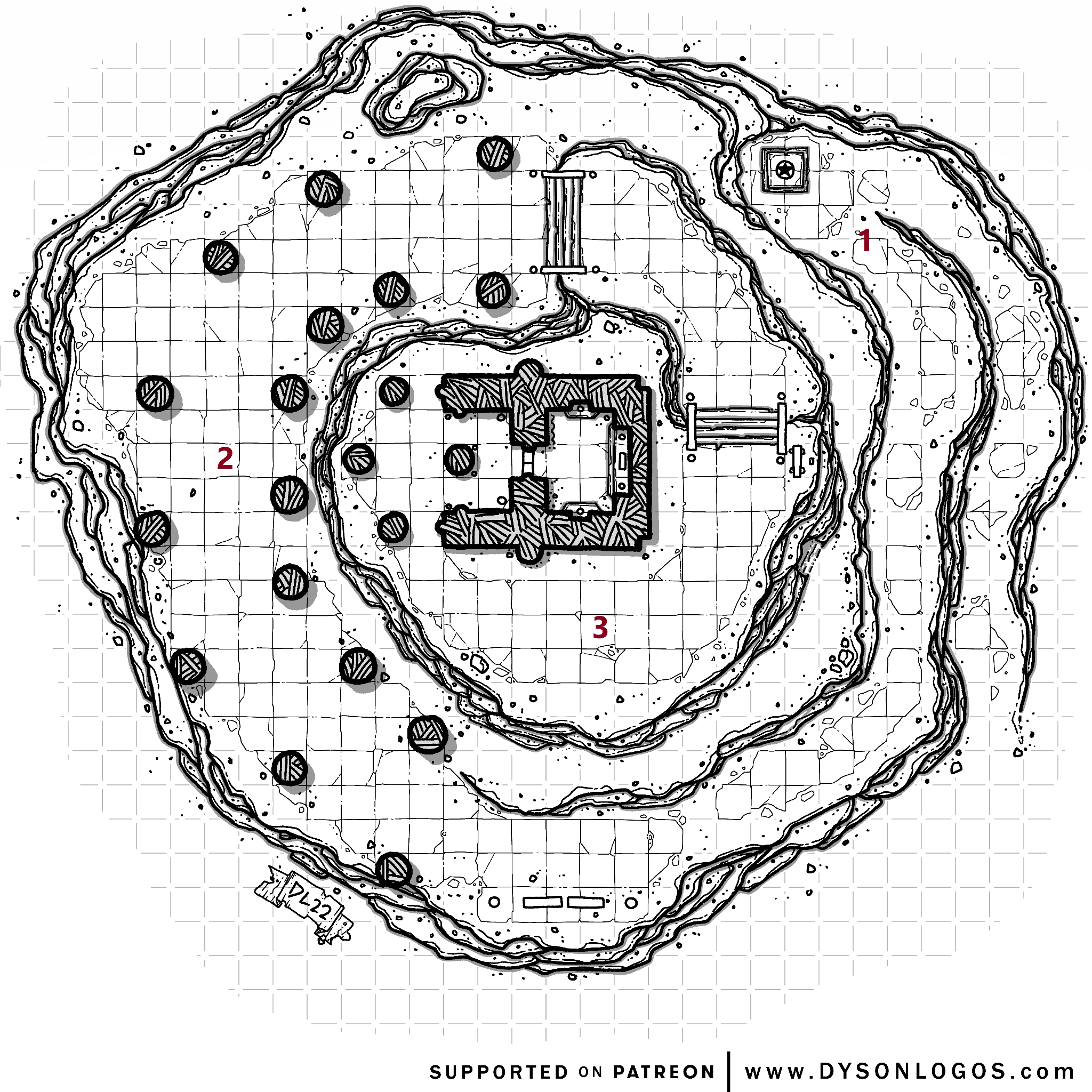
As discussed in the last post, Kobold Press is working on a small, but fierce approach to Sean McCoy’s Dungeon23 project. Throughout 2023, a roster of Kobold Press super stars will work together to create a full dungeon! Each installment contains a few areas that will stack up to a full delve!
This installment sets up the dungeon, provides adventure hooks to bring PCs in, and starts off the dungeon’s entrance.
The Call to Action
In honor of the company sponsoring this effort, kobolds are the first monster. You can find other suitable Humanoid equivalents in the many monster books, made searchable by the Kobold Press Monster Search Tool. (Don’t worry, more foes lurk below the surface.)
You can use any of the following adventure hooks to draw your 1st-level PCs to the dungeon:
- A brazen kobold raiding party stole a magic item from a green dragon’s hoard. The vapor drake (see Tome of Beasts 3) who guarded the hoard hired the PCs to retrieve the stolen object before green dragon returns and discovers its loot is missing.
- A kobold theurge has drawn its kin together as part of a craven ritual to their dark god. The local duke is willing to pay for brave adventurers to disrupt this foul convocation.
- The kobolds who mine local veins of tin quit their jobs and have taken to the hills. Their foreman, a dwarf commoner named Hukrul, wants them back to work before it disrupts the faraway war effort.
| Designer Note: Rule of Threes When playing, I hate feeling like I’ve been railroaded into a particular hook, especially if it doesn’t fit my character. I like to devise more than one adventure hook for GM use. Often, three hooks feels right—it gives a diversity of options without going overboard. |
Dungeon Prompts
I’ve been given the seven words to help inspire dungeon design:
- Granite
- Abrasive
- Slick
- Loud
- Gilded
- Lupine
- Raspy
I don’t need to use any or all of them, but they are cues I can consider using when I’m searching for inspiration.
The Dungeon Map
For our dungeon entrance, we’re using the Dyson Logos’ map, The Shrine Atop Lazuni Hill. This map provides the PCs with a short ascent to the mouth of the dungeon leading to the caverns below.
Area 1: The Ascent

| For the whole foggy afternoon, you’ve pursued kobold tracks through the boondocks of the duchy. As the sun sets, you spy a hill poking above the flatlands. A path wraps around this desolate tor, and a small, granite structure sits at its peak. |
Kobold tracks lead up to the hill, ending at the stone path. Despite the moisture from fog, the PCs easily keep their footing as they ascend this increasing incline.
At the first turn, the PCs encounter the statue of a military leader, now headless from the elements or vandalism. A successful DC 10 Intelligence (History) check reveals the statue’s uniform as belonging to a more advanced, yet ancient culture. A successful DC 13 Wisdom (Perception) check allows a PC to notice part of the statue’s rucksack screws in and out.
PCs who make a successful DC 12 Intelligence (History or Religion) check remember that the ancient culture harshly penalized theft. If a PC doesn’t offer a small sacrifice at the statue’s feet before unscrewing the rucksack, they must succeed on a DC 11 Wisdom saving throw. On a failure, that PC is marked by ill omens. The GM can impose disadvantage on one saving throw or ability check as a consequence. Any ill omen goes away at the end of a short or long rest.
Behind the rucksack, a niche contains three potions of healing and an herbalism kit with dried out supplies.
| Designer Insights: First Level Blues The trickiest part of low level adventure writing is seeding resources to keep the PCs alive and fighting. When any encounter can turn deadly on a lucky 20 and the healers have minimal spell slots, look for places to include healing potions and offer the PCs a chance to rest and spend their hit dice. |
Area 2: The Pillars
| Scaling the western side of the desolate tor, you see stone pillars sticking out of the ground at regular intervals. |
PCs who succeeed on a DC 13 Wisdom (Perception) check see small gilded runes etched around each of the pillars. PCs who read Draconic or succeed on a DC 15 Intelligence (Arcana) check can decipher any rune that they see. Each row of pillars has matching runes that read, in order: red, orange, yellow, green, blue, indigo, violet.
Each “square” of four pillars (don’t try to make it a literal square) marks a boundary area for a rune color. As the PCs proceed up the tor, if more than one creature is in any one “square” at the same time, the surrounding pillars flash the relevant rune’s color.
The kobold guards in area 3 are not particularly attentive, but become alerted to the PCs’ presence after three or more colors flash.
| Designer Insights: Filling in the Map Not everything in a roleplaying game is combat, right? Especially at low levels, puzzles provide meaningful challenge without immediately depleting hit points. |
Area 3: The Entrance
| Two sets of stone steps lead to the top of the path. You hear low voices coming from the top, but can’t make out any words. |
The two sets of steps are slick. PCs moving faster than half their movement speed must make DC 10 Dexterity saving throws or fall prone on the stones. The clatter of their falling equipment alerts the kobolds in this area.
At the hilltop, three kobolds and one kobold spellclerk (see Tome of Beasts 2) nominally guard the dungeon entrance, even if they’re shooting dice. If the PCs don’t reveal their approach up the hill, they can surprise the kobolds. If the PCs do reveal their approach, the kobolds are ready.
The spellclerk, who prepared magic missile instead of sleep, tries to stay out of melee and use the pillars to improve its AC. The other kobolds cluster together in melee to maximize their Pack Tactics feature. Once two kobolds die, the others flee, disengaging and sliding down the tor’s face.
Draconic healing runes have been worked into the four pillars outside the dungeon entrance. Anyone who casts healing spells on a creature in these pillars may reroll the result of any die that recovers hit points.
At the end of this encounter, the PCs should have sufficient XP to reach level 2. They can take a short rest before descending into the dungeon.
| Designer Insights Many GMs assume that monsters fight to the death, but that’s not the only way to play it. While courageous, these kobolds aren’t fools, and they flee once the fight isn’t in their favor. |
Delving Deeper
In two weeks, the dungeon proper opens before us.


Where did you get the 7 words to inspire the dungeon design?